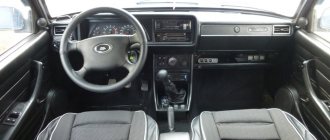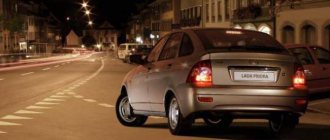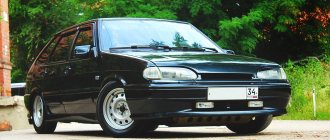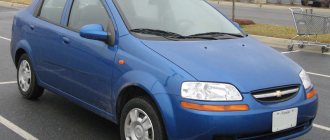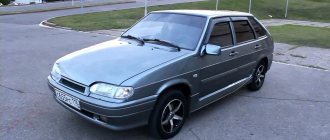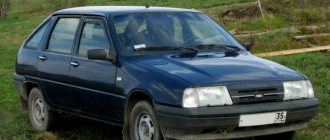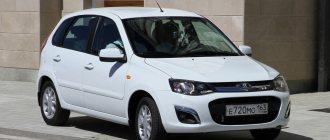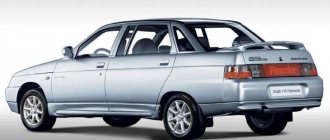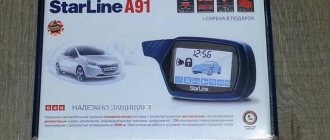VAZ-2104 Zhiguli – video review
The car enjoys a strong reputation as a family car and a delivery van for the city “tent trade”, so, perhaps, the fashion for it will never go away. The following factors played an important role in this: availability of spare parts and service, decent cargo volume in the cabin, relatively modern design (albeit obsolete, but for a station wagon this is not the biggest drawback) and relatively low cost. In the basic configuration, the interior trim is quite ascetic, like that of the basic VAZ-2105 sedan.
At the same time, they produced a more powerful modification of the VAZ-21043 with a VAZ-2103 engine with a displacement of 1.5 liters (carburetor 2107) and a five-speed manual transmission VAZ-21074, completely unified with a four-speed gearbox, which makes the car more dynamic and pleasant to drive. Some cars, starting from the 90s, are equipped with a VAZ-2107 type dashboard. The cost in this case is slightly higher. Station wagons of the VAZ-21047 modification, equipped with a radiator trim, a five-speed gearbox, electrical equipment and an interior with bucket front seats from the VAZ-2107, are valued even more expensive on the market. In fact, this option can be considered a modification of the VAZ-2107 with a station wagon body.
The modernizations that affected the VAZ-2105 or VAZ-2106 models were left aside, but nevertheless, some differences in the electrical and power systems are possible on the 1984, 1988 and 1990 models. The folding rear row of seats allows you to increase the volume of the luggage compartment from 375 to 1340 liters, and then you can even transport a two-chamber refrigerator in a package. But the back of the rear seat folds only entirely, because of this it is impossible to transport long cargo and one or two passengers in the back seat at the same time.
The body design allows you to place a long trunk on the roof, but it is not recommended to overload it: the calculated rigidity of the station wagon body is significantly lower than that of the VAZ-2105 and VAZ-2107 sedans (therefore, there are stampings on the roof panel to increase rigidity). The total load of the car should not exceed the permissible 455 kg, otherwise during movement, due to dynamic loads, the body and load-bearing parts will deform and disrupt the suspension geometry. You should also not get carried away with towing heavy trailers - the body may “drive”. By the way, because of this, you should not overpay for the presence of a tow bar on a used vehicle.
Therefore, when buying a VAZ station wagon from two or three years ago, test the car on the move and carefully (it is advisable to invite a specialist) examine the mounting locations of the suspension shock absorbers, levers and power elements of the chassis. The lifting rear door on cars until 1994 was equipped with windshield wipers only in export versions, among which recently versions of the VAZ-21044 (1.7-liter engine) equipped with a central injection system instead of a carburetor and a catalytic converter have become common. The VAZinterservice company, based on a station wagon, assembled the VAZ-21043-33 pickup truck with a carrying capacity of 450 kg in small batches.
Test
Tribute to tradition
Despite the fact that the Lada 2104 is a more modern analogue of the 2102 model, the overall dimensions of the body, as well as its proportions, have been preserved. And, that's not a bad thing. The Russian station wagon still looks harmonious and even swift. In addition, rectangular lights visually expand the front part of the body.
Nothing extra
Compared to the VAZ 2102, the Four's interior looks more laconic, but at the same time more functional. The instrument panel with tachometer is quite informative. The indicator lamps are not dispersed throughout the dashboard, but are arranged in a row in its center, which makes them easier to read.
The climate system is located on the dashboard - it is regulated by sliders. The center console is made voluminous, which not only has a positive effect on the overall design of the front panel, but also allows you to place small luggage in it.
The front seats are not devoid of profile, which makes long trips relatively comfortable. The width of the rear sofa can accommodate three people, but there is very little space for knees. The trunk size in its original state cannot be called outstanding - 345 liters, but the volume can be increased to 1 cubic meter by folding the rear sofa.
Minimum Required
The most modern in the power range is the 1.6 liter engine with an injection system. Its 74 forces are quite enough to move relatively quickly in the city.
The main thrust occurs in the range of 2500-4000 rpm, so to obtain distinct acceleration there is no need to press the accelerator pedal hard to the floor.
Handling is unremarkable. The steering wheel is oversaturated with reactive force and seems heavy, but at high speed its information content drops sharply, so you have to register the trajectory of movement “by touch.”
Sharp maneuvers are strictly contraindicated for this station wagon, because rolls and sway are significant.
The long-travel suspension copes well with rough roads. However, the smoothness of the ride on large potholes cannot be called high due to the presence of noticeable shocks.
Photo VAZ 2104:
Technical characteristics of the VAZ-2104
– Body type: 5-door. station wagon (5-seater)
Engine VAZ-2104
– VAZ-2103 Volume: 1458 cm3, Max. power: 59.2 kW (80 hp) – VAZ-2105 Volume: 1290 cm3, Max. power: 46 80 kW – VAZ-21067 Volume: 1569 cm3, Max. power: 60.2 kW (82 hp) – VAZ-21073 Volume: 1689 cm3, Max. power: 62 kW (84 hp) – VAZ-341 Volume: 1524 cm3 Max. power: 37 kW (50 hp)
Gearbox: 4-speed / 5-speed mechanical
Maximum speed of VAZ-2104
– 137-153 km/h depending on the engine
VAZ-2104 tire size
Tank volume VAZ-2104
Fuel consumption VAZ-2104
– city 10.3 l; highway 7.4 l; in a mixed cycle 9 l. per 100 km
Ecological class VAZ-2104
Overall dimensions of VAZ-2104
– Length: 4115 mm – Width: 1620 mm – Height: 1443 mm – Ground clearance: 170 mm – Wheelbase: 2424 mm – Rear / front track, mm: 1321 / 1365
Load capacity of VAZ-2104
Weight VAZ-2104
– Vehicle curb weight: 1050 kg – Gross weight: 1475 kg
How much does a car weigh?
A car's directional stability and handling are also directly related to its weight. The peak of popularity of large, heavy cars abroad occurred in the 50-60s of the last century. Then the auto industry produced truly gigantic cars. For example, the Cadillac Eldorado modification 8.2 weighed almost 3 tons. Agree that for such a weight, an appropriate makeweight is needed.
But as time passed, it became clear that in order to further develop and improve the most important characteristics of the car, it was necessary to resort to reducing its overall weight. And if we compare the middle of the last century and today, cars have lost half, or even more, of their own weight. Plastic, carbon fiber reinforced plastic, light metals - all these innovations have made it possible to make the weight of a passenger car significantly lower.
Of course, for lovers of everything big and heavy, cars are produced that look like steamships that drink buckets of gasoline, but this is rather an exception to the rule.
Undesirability of producing gasoline residues
It is highly undesirable to run out of gasoline for several reasons. Firstly, during sharp acceleration or when driving uphill, there are many cases when the engine stalls due to air entering the fuel system (namely, in such modes, the flow of the fuel mixture into the cylinders should be maximum). Secondly, the electric fuel pump is cooled during operation by being immersed in fuel.
If there is a lack of gasoline, the pump begins to work under more difficult conditions and may fail due to overheating.
Weight of passenger cars in tabular format
We present to your attention a table that shows the weight of the car by brand.
| car model | Curb weight |
| Weight of the Oka 1111 car, weight of the Okushka | 635 kg |
| Weight of the car Oka 1113 | 645 kg |
| Weight of a VAZ 2101 car, weight of a penny | 955 kg |
| Weight of the VAZ 2102 car | 1010 kg |
| Weight of the VAZ 2103 car | 965 kg |
| Weight of the car VAZ 2104, weight of tens 2110 | 1020 kg |
| The weight of the VAZ 2105 car, the weight of the five | 1060 kg |
| Weight of the VAZ 2106 car, weight of the six | 1045 kg |
| Weight of the VAZ 2107 car, weight of the seven | 1049 kg |
| Weight of the VAZ 2108 car | 945 kg |
| Weight of the VAZ 2109 car, weight of the nine | 915 kg |
| Weight of the VAZ 2111 car | 1055 kg |
| Weight of a VAZ 2112 car, weight of a twelve-wheeler | 1040 kg |
| Weight of the VAZ 2113 car | 975 kg |
| Weight of the VAZ 2114 car, weight of the four | 985 kg |
| Weight of the VAZ 2115 car, weight of the tag | 1000 kg |
| Weight of the VAZ 2116 car | 1276 kg |
| Weight of the VAZ 2117 car | 1080 kg |
| Weight of the Niva 2121 car | 1150 kg |
| How much does a Chevrolet Cruze weigh (Chevrolet Cruze weight) | 1285-1315 kg |
| How much does a Chevrolet Niva weigh (Chevrolet Niva weight) | 1410 kg |
| How much does a GAZ (Volga) weigh, the weight of a Volga is 24 | 1420 kg |
| How much does GAZ 2402, GAZ 2403, GAZ 2404 weigh? | 1550 kg |
| How much does GAZ 2407 weigh? | 1560 kg |
| Car weight Moskvich 314 | 1045 kg |
| Weight Moskvich 2140 | 1080 kg |
| Weight Moskvich 2141 | 1055 kg |
| Car weight Moskvich 2335, 407, 408 | 990 kg |
| How much does a UAZ 3962, UAZ 452 weigh, how much does a UAZ loaf weigh? | 1825 kg |
| How much does UAZ 469 weigh? | 1650 kg |
| How much does UAZ Patriot weigh? | 2070 kg |
| How much does UAZ Hunter weigh? | 1815 kg |
| How much does Nissan weigh (weight of nissan x-trail car) | 1410-1690 kg |
| How much does Qashqai weigh (weight of Nissan Qashqai car) | 1297-1568 kg |
| How much does a Nissan Juke weigh (Nissan Beetle weight) | 1162 kg |
| Ford Focus car weight (how much does a Ford Focus weigh) | 965-1007 kg |
| Weight of the Ford Focus 2 car (how much does the Ford Focus 2 weigh) | 1345 kg |
| Weight of the Ford Focus 3 car (how much does the Ford Focus 3 weigh) | 1461-1484 kg |
| Ford Kuga car weight (how much does a Ford Kuga weigh) | 1608-1655 kg |
| Weight of the Ford Escort (how much does the Ford Escort weigh) | 890-965 kg |
| Weight of the Renault Logan car (how much does the Renault Logan weigh) | 957-1165 kg |
| Renault Duster car weight (how much does a Renault Duster weigh) | 1340-1450 kg |
| Renault Sandero car weight (how much does a Renault Sandero weigh) | 941 kg |
| Weight of the Opel Mokka car (how much does the Opel Mokka weigh) | 1329-1484 kg |
| Weight of the Opel Astra car (how much does the Opel Astra weigh) | 950-1105 kg |
| Mazda 3 car weight (how much does mazda 3 weigh) | 1245-1306 kg |
| Weight of the Mazda CX-5 (how much does the Mazda CX-5 weigh) | 2035 kg |
| Mazda 6 car weight (how much does mazda 6 weigh) | 1245-1565 kg |
| Volkswagen car weight (how much does a Volkswagen Tuareg weigh) | 2165-2577 kg |
| Weight of a Volkswagen Polo car (how much does a Volkswagen Polo weigh) | 1173 kg |
| Weight of the Volkswagen Passat car (how much does the Volkswagen Passat weigh) | 1260-1747 kg |
| How much does a Toyota Camry weigh (weight of a Toyota Camry) | 1312-1610 kg |
| How much does Toyota Corolla weigh (weight of Toyota Corolla) | 1215-1435 kg |
| How much does a Toyota Celica weigh (Toyota Celica weight) | 1000-1468 kg |
| How much does a Toyota Land Cruiser weigh (Land Cruiser weight) | 1896-2715 kg |
| How much does the Skoda Octavia weigh (weight of Skoda Octavia) | 1210-1430 kg |
| How much does the Skoda Fabia weigh (Skoda Fabia weight) | 1015-1220 kg |
| How much does the Skoda Yeti weigh (Skoda Yeti weight) | 1505-1520 kg |
| How much does a Kia Sportage weigh (KIA Sportage weight) | 1418-1670 kg |
| How much does Kia Sid weigh (weight of KIA Ceed) | 1163-1385 kg |
| How much does the Kia Picanto weigh (KIA Picanto weight) | 829-984 kg |
Fuel level indicator: checking and replacing the fuel sensor
The fuel level indicator (type UB-193) works in conjunction with the BM-892 (891) sensor installed in the fuel tank. The sensor is made in the form of a rheostat made of nichrome wire.
Fuel level indicator UB-193
The movable contact of the rheostat is moved by the float lever. At the end of the lever there is an additional contact that closes the warning lamp circuit when there are 4-6.5 liters of fuel left in the tank.
Note: the fuel level indicator type 19.3806 for the VAZ 2107 is slightly different from the housing indicators for the VAZ 2101-2106, 2121. The main differences: it does not have its own housing, the zone scale is painted yellow-green, it is included in the instrument cluster 151.3801 and its modifications .
The fuel level indicator does not work, what should I do?
The instrument needle constantly shows a full tank
With the ignition on, disconnect the pink wire from the sensor. If the arrow returns to the beginning of the scale, the sensor is faulty. Otherwise, either the device does not work or the wire is shorted to ground. To check, remove the instrument cluster, disconnect the gray wire with a red stripe from the indicator and turn on the ignition. If the arrow returns to the beginning of the scale, the fuel level gauge is working, but the wire is damaged.
How much does the VAZ weigh?
Perhaps one of the most popular cars in the post-Soviet space was, is and remains the VAZ.
This car has captivated many generations. However, how did it all begin? When was the first VAZ car produced and how much did it weigh? You will learn the answers to these and other questions from this article. The first VAZ car was produced by the Volzhsky Automobile Plant on April 19, 1970. The make of this car was VAZ-2101 Zhiguli. Its production was carried out according to the analogue of the Fiat concern. Moreover, VAZ owes its appearance to this particular brand of Fiat 124, produced in 1966. Here, in fact, is it:
As a result of some design improvements, the first domestic car, the VAZ 2101 of 1970, was produced:
The weight of this car was 955 kg. Moreover, of this mass the engine weighed 114 kg.
It has not lost its popularity to this day. In 2000, it was recognized as the best car among eighty thousand car enthusiasts surveyed in the CIS countries and Russia. It was named the best car of the century, VAZ 2101. At the time of its production, it was considered the most comfortable, reliable and modern domestic car. Its presence was a sign of wealth and prosperity!
But the Volzhsky Automobile Plant did not stop there. He created entire collections of this car. Each of them differed in its configuration, as well as its total weight. Therefore, now we will compare some VAZ models by their weight.
- VAZ 2102 has a weight of 1010 kg .
- VAZ 2103 has a weight of 965 kg .
- VAZ 2104 has a weight of 1020 kg .
- VAZ 2105 has a weight of 1060 kg .
- VAZ 2106 has a weight of 1045 kg .
- VAZ 2107 weighs 1049 kg .
- VAZ 2108 weighs 945 kg .
- VAZ 2109 weighs 915 kg .
- VAZ 2110 has a weight of 1020 kg .
- VAZ 2111 has a weight of 1055 kg .
- VAZ 2112 has a weight of 1060 kg .
- VAZ 2113 weighs 975 kg .
- VAZ 2114 weighs 985 kg .
- VAZ 2115 has a weight of 1000 kg .
- VAZ 2116 weighs 1276 kg .
- VAZ 2117 has a weight of 1110 kg .
- VAZ 2118 has a weight of 1110 kg .
- VAZ 2119 has a weight of 1110 kg .
- VAZ 2120 has a weight of 1110 kg .
- VAZ 2121 has a weight of 1550 kg .
- VAZ 2122 has a weight of 1122 kg .
- VAZ 2123 has a weight of 1300 kg .
But this is the total weight of a VAZ car. As for some parts of the car, the weight of, for example, a VAZ 2106 can be decomposed as follows:
- The weight of the engine with equipment is 140 kilograms .
- The weight of the gearbox is 26 kilograms .
- The weight of the square shaft is 10 kilograms .
- The weight of the rear axle is 52 kilograms .
- Radiator weight – 7 kilograms .
- Body weight – 280 kilograms .
On average, the weight of all components of a VAZ car has approximately the same mass. Throughout the entire period of existence of this car, quite interesting facts have been recorded that simply cannot be ignored. It’s hard to imagine that a car weighing an average of 1 ton is very popular.
So, the VAZ 2121 Niva car is not only the most popular throughout the USSR, but also the most exported. Just imagine, this model was produced in 1.8 million cars. And of this amount, 500,000 were sold to more than 100 countries. As we remember, the weight of the VAZ 2121 is 1550 kilograms . This means that over the entire period, 775,000,000 kilograms of this car were sold! Also, this particular model of all Soviet cars was driven in Japan. As for the design of the VAZ 2108, it was developed by the currently well-known company Porshe. Its engine weighs 127.3 kilograms . This became necessary due to the fact that the demand for this brand of car was greatly reduced. For this reason, they decided to modernize it.
Communities › Auto club VAZ and Lada Classic. › Blog › Model VAZ-2104
VAZ-2104 is a rear-wheel drive passenger car with a station wagon body. Developed at the Volzhsky Automobile Plant. Produced since 1984 Serial production of the VAZ-2104 car was started at the Volzhsky Automobile Plant in 1984. The new model was produced in parallel with the VAZ-2102 car of a similar class until 1985. When creating this model, the designers were guided by an important feature of that time - the creation of a new model with minimal production costs and maximum consumer effect. Therefore, the VAZ-2105 model was taken as a basis. After lengthening the roof, stampings appeared to increase rigidity. This body design made it possible to place a long trunk on the roof, which was not recommended to be overloaded, since the calculated rigidity of the station wagon body was significantly lower than that of a sedan. The new model featured a rear door that opened upwards; in addition, a completely new solution was used, a heated rear window and a windshield wiper, which later became standard equipment, since until 1994 only export versions and the modification of the VAZ-21043 were equipped. The interior for the new model was borrowed from the base model with the exception of the rear seat. The folding rear seat allows you to increase the volume of the luggage compartment from 375 to 1340 liters, and then you can transport large cargo. The total vehicle load has increased to 455 kg. In the basic configuration, the interior trim is quite simple. The Spartan version assumes a standard panel with a minimum required set of instruments, upholstery and seats with standard removable faux leather headrests and rubber floor mats. The desire for greater comfort is proposed to be satisfied with improved seat upholstery made of brushed jersey, solid-molded door linings, brushed floor mats, an instrument panel with an additional center console, which has an expanded set of functional keys and control equipment, and an original steering wheel. Later, a station wagon modification of the VAZ-21047 appeared on the market, equipped with a five-speed gearbox, electrical equipment and an interior with anatomical front seats from the VAZ-2107. From 1999 to 2006, a modification of the VAZ 21045 was produced with a 1.52-liter diesel engine produced by Barnaultransmash.
• VAZ-2104 - VAZ-2105 engine, 1.3 liters, carburetor, with 4-speed gearbox (gearbox), base model • VAZ-21041 - VAZ-2101 engine, 1.2 liters, carburetor with 4-speed . Checkpoint. Not serially produced. • VAZ-21042 - VAZ-2103 engine, 1.5 liters, right-hand drive • VAZ-21043 - VAZ-2103 engine, 1.5 liters, carburetor with 4 or 5 speed. Gearbox, in versions with electrical equipment and interior from the VAZ-2107 • VAZ-21044 - VAZ-2107 engine, 1.7 liters, single injection, 5-speed. Gearbox, export model • VAZ-21045 - VAZ-2107 engine, 1.8 liters, single injection, 5-speed. Gearbox, export model. Not serially produced. • VAZ-21045D - VAZ-341 engine, 1.5 liters, diesel, 5-speed. Gearbox • VAZ-21047 - VAZ-2103 engine, 1.5 liters, carburetor, 5-speed. Gearbox, an improved version with the interior of a VAZ-2107. Export modifications were equipped with a radiator grille from the VAZ-2107. • VAZ-21048 - VAZ-343 engine, 1.8 liters, diesel, 5-speed. Gearbox • VAZ-21041 - VAZ-21067 engine 1.7 liter injector, 5-speed gearbox, interior and electrical equipment of VAZ 2107
Technical characteristics of the car
Model 2104, 21041 21043 21043-03 21044 21045
Body type station wagon Seats 5 Doors 5 Trunk volume 345/1035
Dimensions and weight of the car
Length4115 Width without mirrors1620 Height1443 Own weight1020 Payload455 Base2424 Front track1365 Rear track1321 Ground clearance to the engine oil pan.182 Ground clearance to the rear axle beam170 Ground clearance to the lane beam. pendants175
Engine 2105 2101 2103 VAZ-3411 Displacement, l 1.294 1.198 1.452 1.452 1.452 Rated power at a crankshaft speed of 5600 min-1 according to GOST 14846 (net) 47.0 (63.9) 43.2 (58.7) 52.3 (71.1) 52.3 (71.1) 38.7* (52.6) * At a crankshaft speed of 4800 min-1 Compression ratio 8.5 8.5 8.5 8.5 23 Tires Tube, radial 165/70 R13 or 165/80R13 (165SR13) Wheels Disc, stamped Rim size 127J-330(5J-13) Drive Rear wheels Front suspension Independent, on wishbones, with coil springs, telescopic hydraulic shock absorbers and anti-roll bar Rear suspension Five-bar. Dependent, rigid beam connected to the body by one transverse and four longitudinal rods, with coil springs and hydraulic shock absorbers
Clutch Single-plate, dry, with central pressure spring Gearbox Mechanical, three-way, four- or five-speed, with synchronizers in all forward gears Number of gearbox stages 5 or 4 Gearbox ratios I 3.636 II 1.95 III 1.357 IV 0.941 V 0.784 Reverse 3.53 Final drive ratio 4.1 4.1 4.1 or 3.9 4.1 or 3.9 4.1 or 3.9 4.1 or 3.9
Front brakes Disc with two opposing hydraulic cylinders and automatic restoration of the set gap Rear brakes Drum with self-centering shoes, with automatic restoration of the gap between the shoes and the drum, with pressure regulator Service brake drive Foot, hydraulic, dual-circuit, with a vacuum booster Parking brake drive Cable clutch drive Hydraulic
Steering Injury-proof, with an intermediate cardan shaft Steering gearbox With globoidal worm and double-ridge roller on ball bearings, gear ratio 16.4 Steering drive Three-link, consists of one middle and two lateral symmetrical rods, bipod, pendulum and swing arms
Electrical wiring system Single-wire, the negative pole of the current sources is connected to ground. Rated voltage, 12 V Battery ** 6ST55P, capacity 55 Ah at 20-hour discharge mode Generator 37.3701, alternating current with built-in rectifier and voltage regulator. Return current 55 A at 5000 min” Starter 35.3708, with electromagnetic traction relay and freewheel, power 1.3 kW Spark plugs A17DV or FE 65 P with M14X1.25 thread
Diesel modification [edit | edit code]
In 1999, a modification of the VAZ 21045
with a VAZ-341 diesel engine produced by Barnaultransmash with a volume of 1.52 liters and a Bosch injection pump.
Since 2005, it was planned to install a more powerful version of a 1.8-liter diesel engine (modification of the VAZ-21048
), but these plans remained unrealized [4].
The diesel modification was distinguished by a significantly higher cost and lower power of the power plant, despite the fact that in these years diesel fuel was noticeably cheaper than gasoline, the economic feasibility of purchasing this version was in doubt [ source not specified 1528 days
] .
In 2004, production of the VAZ-21045 was discontinued; the remaining unspecified diesel engines in the amount of 500 pieces were completed in a batch of the new modification of the VAZ-21055 [5].
Model review: VAZ 2104 without embellishment
Few people know that the VAZ 2104 (“four”) also bears the foreign name Lada Nova Break. This is a five-seater station wagon, which belongs to the second generation of AvtoVAZ “classics”.
The first models left the factory in September 1984 and thereby replaced the first generation station wagon - VAZ 2102. Although for another year (until 1985) the Volzhsky Automobile Plant produced both models simultaneously.
VAZ 2104 cars were created on the basis of the VAZ 2105, only they had significant differences:
- extended rear part;
- folding rear bench;
- increased gas tank up to 45 liters;
- rear wipers with washer.
It must be said that the “four” were actively exported to other countries. In total, 1,142,000 VAZ 2104 units were produced.
Along with the VAZ 2104, its modification was also produced - the VAZ 21043. This is a more powerful car with a 1.5 liter carburetor engine and a five-speed gearbox.
Video: review of the Quartet
Notes
- Until 2003, it was produced at AvtoVAZ, then production was transferred to the IzhAvto conveyor. In addition, at the RosLada plant in Syzran, production of the VAZ-2104 with diesel engines began, but it was soon curtailed. IzhAvto produced the “four” in various configurations from 2003 to 2009 (source: “Autolegends of the USSR” magazine), then production was stopped due to financial difficulties. However, since September 2010, the plant resumed production of the LADA 2104. Production of the car at IzhAvto ceased on September 17, 2012
- The maximum permitted weight is indicated in brackets, and the curb weight is indicated outside the brackets.
Specifications
A car in a station wagon weighs a little, only 1020 kg (for comparison: the “five” and “six” in a sedan body weigh more - from 1025 kg). The dimensions of the VAZ 2104, regardless of the configuration, are always the same:
- length - 4115 mm;
- width - 1620 mm;
- height - 1443 mm.
Thanks to the folding rear row, the trunk volume can be increased from 375 to 1340 liters, which made it possible to use the car for private transportation, country work and even small businesses. However, the back of the rear sofa does not fold entirely (due to the specific design of the car), so it is impossible to transport long cargo.
However, long elements are easy to fix on the roof of the car, since the length of the VAZ 2104 allows you to transport beams, skis, boards and other long items without the risk of creating dangerous road situations. But you cannot overload the roof of the car, since the calculated rigidity of the station wagon body is much lower than that of sedans of the next generations of VAZ.
The total load on the vehicle (passengers + cargo) should not exceed 455 kg, otherwise damage to the chassis may occur.
The “Four” was equipped with two types of drives:
- FR (rear-wheel drive) is the basic equipment of the VAZ 2104. Allows you to make the car more powerful.
- FF (front-wheel drive) - selected models were equipped with front-wheel drive, as it is considered safer; subsequent versions of the VAZ began to be produced only in front-wheel drive.
Like other Lada representatives, the Four has a ground clearance of 170 mm. Even today, this is a completely reasonable ground clearance, allowing you to overcome major road obstacles.
Engine characteristics
Over the years, the VAZ 2104 was equipped with power units of different power: from 53 to 74 horsepower (1.3, 1.5, 1.6 and 1.8 liters). Two modifications (21048D and 21045D) used diesel fuel, but all other versions of the “four” consumed AI-92 gasoline.
Depending on the engine power, fuel consumption also varies.
Table: average fuel consumption per 100 km
| Options | Fuel consumption, l/100 km | Fuel used |
| 1.8MT 21048D | 5,5 | Diesel fuel |
| 1.5MT 21045D | 8,6 | Diesel fuel |
| 1.6MT 21041 | 8,8 | Gasoline AI-92 |
| 1.3MT 2104 | 10,0 | Gasoline AI-92 |
| 1.5MT 21043i | 10,3 | Gasoline AI-92 |
| 1.5MT 21043 | 10,3 | Gasoline AI-92 |
The VAZ 2104 accelerates to a speed of 100 km/h in 17 seconds (this is a standard indicator for all VAZs produced in the 1980–1990s). The maximum speed of the machine (according to the operating instructions) is 137 km/h.
Table: parameters of the “four” motor
| Number of cylinders: | 4 |
| Cylinder displacement, l: | 1,45 |
| Compression ratio: | 8,5 |
| Rated engine power at a crankshaft speed of 5000 rpm: | 50.0 kW.- (68.0 hp) |
| Cylinder diameter, mm: | 76 |
| Piston stroke, mm: | 80 |
| Number of valves: | 8 |
| Minimum crankshaft speed, rpm: | 820–880 |
| Maximum torque at 4100 rpm, N*m: | 112 |
| Cylinder operating order: | 1–3-4–2 |
| Octane number of gasoline: | 95 (unleaded) |
| Fuel supply system: | Electronically controlled distributed injection |
| Spark plug: | А17ДВРМ, LR15YC-1 |
Design features [edit | edit code]
Since the front part of the car is identical to models with a sedan body, it is more difficult for a standard heater to warm a larger volume of the interior during the cold season. The back of the car often fogs up in cold weather. The car normally does not have rear ventilation holes for venting interior air (unlike the VAZ-2107), which makes it difficult to close the doors (with the windows closed). Compared to the VAZ-2105, 2107 (with identical engine installations), it has a lower maximum speed (data from the “operating instructions”
142 km/h) due to the changed final drive ratio - 4.44 (early modifications) versus 4.3 on the sedan. The rear door is subject to contamination by road dirt (dust raised by wheels), which is locally drawn when driving at high speeds into the low-pressure zone - this is corrected by installing an upper deflector on the 5th door, supplying (to the low-pressure zone) cleaner air from the roof. There is also a way to avoid the accumulation of dirt on the back door - this is to change the design of the rear bumper - the lower part must be bent in the opposite direction and the gap between the bumper and the body must be closed - a plate 1 meter by 15 cm in the middle. The gas tank with a volume of 43 liters (versus 39) is located horizontally under the bottom of the trunk without additional protection - there is a risk of damage when driving over rough terrain.
Vehicle interior
The original interior of the VAZ 2104 has an ascetic design. All devices, parts and products are designed to perform their functions; there are no decorations or even a hint of any design solution. The task of the model's designers was to make a working car, suitable for passenger and cargo transportation, without focusing on comfort and beauty.
The interior contains the minimum necessary set of instruments and vehicle controls, standard upholstery in wear-resistant fabric and removable faux leather headrests on the seats. The picture is complemented by standard rubber mats on the floor.
The design of the Four's interior was borrowed from the base model, with the exception of the rear sofa, which was made foldable for the first time in the history of VAZ models.
Interior and control design
In general, the design of the VAZ-2104 model
, like all classic models, ascetic. But the interior of the car can be different depending on your desire. A more economical option involves a standard panel with a minimum required set of switches and instrumentation, upholstery and seats with standard artificial leather headrests, and rubber floor mats. If you want more comfort, then you are offered an improved interior, an original steering wheel and instrument panel with an additional center console, which has an expanded set of function keys and control equipment. The improved interior includes seats upholstered in brushed jersey (the front ones have a high backrest), doors with integrally molded pads, and brushed floor mats. This version of the “four” will allow you to feel comfortable even on a long trip.

